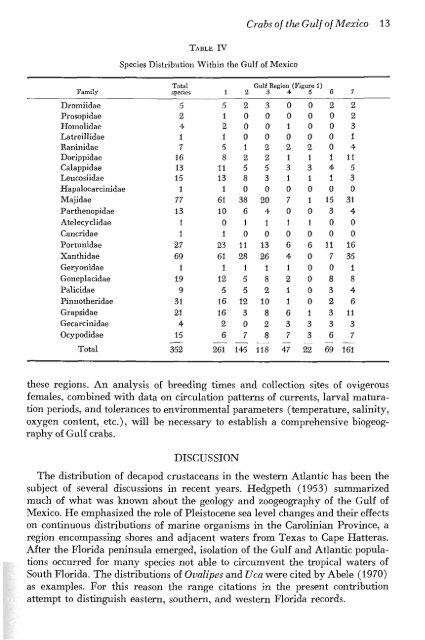You also want an ePaper? Increase the reach of your titles
YUMPU automatically turns print PDFs into web optimized ePapers that Google loves.
Family<br />
Dromiidae<br />
Prosopidae<br />
Homolidae<br />
Latreillidae<br />
Raninidae<br />
Dorippidae<br />
Calappidae<br />
Leucosiidae<br />
Hapalocarcinidae<br />
Majidae<br />
Parthenopidae<br />
Atelecyclidae<br />
Cancridae<br />
Portunidae<br />
Xanthidae<br />
Geryonidae<br />
Goneplacidae<br />
Palicidae<br />
Pinnotheridae<br />
Grapsidae<br />
Gecarcinidae<br />
Ocypodidae<br />
Total<br />
TABLE IV<br />
Species Distribution Within the Gulf of Mexico<br />
Total<br />
species<br />
5<br />
2<br />
4<br />
1<br />
7<br />
16<br />
13<br />
15<br />
1<br />
77<br />
13<br />
1<br />
1<br />
27<br />
69<br />
1<br />
19<br />
9<br />
31<br />
21<br />
4<br />
15<br />
352<br />
1<br />
5<br />
1<br />
2<br />
1<br />
5<br />
8<br />
11<br />
13<br />
1<br />
61<br />
10<br />
0<br />
1<br />
23<br />
61<br />
1<br />
12<br />
5<br />
16<br />
16<br />
2<br />
6<br />
261<br />
Crabs of the Gulf of Mexico 13<br />
2<br />
2<br />
0<br />
0<br />
0<br />
1<br />
2<br />
5<br />
8<br />
0<br />
38<br />
6<br />
1<br />
0<br />
11<br />
28<br />
1<br />
5<br />
5<br />
12<br />
3<br />
0<br />
7<br />
145<br />
Gulf Region (F. Igure 1)<br />
3 4 5<br />
these regions. An analysis of breeding tiraies and collection sites of ovigerous<br />
females, combined with data on circulation patterns of currents, larval maturation<br />
periods, and tolerances to environmental parameters (temperature, salinity,<br />
oxygen content, etc.), will be necessary to establish a comprehensive biogeography<br />
of Gulf crabs.<br />
DISCUSSION<br />
The distribution of decapod crustaceans in the western Atlantic has been the<br />
subject of several discussions in recent years. Hedgpeth (1953) summarized<br />
much of what was knowia about the geology and zoogeography of the Gulf of<br />
Mexico. He emphasized the role of Pleistocene sea level changes and their effects<br />
on continuous distributions of marine organisms in the Carolinian Province, a<br />
region encompassing shores and adjacent waters from Texas to Cape Hatteras.<br />
After the Florida peninsula emerged, isolation of the Gulf and Atlantic populations<br />
occurred for many species not able to circumvent the tropical waters of<br />
South Florida. The distributions of Ovalipes and Uca were cited by Abele (1970)<br />
as examples. For this reason the range citations in the present contribution<br />
attempt to distinguish eastern, southern, and western Florida records.<br />
3<br />
0<br />
0<br />
0<br />
2<br />
2<br />
5<br />
3<br />
0<br />
20<br />
4<br />
1<br />
0<br />
13<br />
26<br />
1<br />
8<br />
2<br />
10<br />
8<br />
2<br />
8<br />
118<br />
0<br />
0<br />
1<br />
0<br />
2<br />
1<br />
3<br />
1<br />
0<br />
7<br />
0<br />
1<br />
0<br />
6<br />
4<br />
1<br />
2<br />
1<br />
1<br />
6<br />
3<br />
7<br />
47<br />
0<br />
0<br />
0<br />
0<br />
2<br />
1<br />
3<br />
1<br />
0<br />
1<br />
0<br />
1<br />
0<br />
6<br />
0<br />
0<br />
0<br />
0<br />
0<br />
1<br />
3<br />
3<br />
22<br />
6<br />
2<br />
0<br />
0<br />
0<br />
0<br />
1<br />
4<br />
1<br />
0<br />
15<br />
3<br />
0<br />
0<br />
11<br />
7<br />
0<br />
8<br />
3<br />
2<br />
3<br />
3<br />
6<br />
69<br />
7<br />
2<br />
2<br />
3<br />
1<br />
4<br />
11<br />
5<br />
3<br />
0<br />
31<br />
4<br />
0<br />
0<br />
16<br />
35<br />
1<br />
8<br />
4<br />
6<br />
11<br />
3<br />
7<br />
161

















